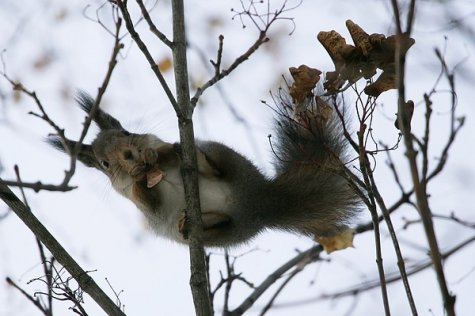Fur has turned wintery
Photo: Arne Ader
Translation: Liis
Squirrel eating maple seeds
|
Red squirrel |
Harilik orav |
The doings of the squirrels in the park with their day-time life style are easy to observe, but we can meet them in nearly all kinds of forests too: conifer, mixed and deciduous. This year is a cone year and the life of the cone kings again a bit easier. The scarcity of cones and the severe and snow-rich winters of the last few years have not been favourable for the number s of squirrels.
Collecting winter food supplies began already at the end of summer: nuts, acorns, mushrooms, tree or plant seeds. In autumn snail hunts were held on the ground. Suitable for storing the supplies are free tree hollows, nest boxes of birds, buildings entered through some crack, or the finds are hid in moss, but a snow cover can hide such stores irretrievably. For some reason squirrels are associated with spruce cones; however, pine cone seeds are no substitute but an equally valuable nutrient for the little creatures..
Every squirrel has several warmly lined night-time nests. Existing ones are used for storage of winter supplies, some crow’s nests are adapted and insulated, if ready ones are not available a quite new nest is built close to a tree trunk – for instance in a pleasantly sheltering spruce. Squirrels know how to warm the nest nicely, sometimes in cold or snowdrifts they will not come out until the weather gets better. Why do squirrels have several night places? Change of nest is forced on by tormenting fleas; with frost these will certainly be fewer after some weeks. That seems to be the experience of squirrels.
The changes in the fur coat and the ear tufts are worth noting. To be sure, the autumn weather is warm but the day length clearly signals approaching winter.









